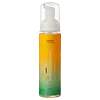What's inside
What's inside
 Key Ingredients
Key Ingredients

No key ingredients
 Benefits
Benefits

 Concerns
Concerns

 Ingredients Side-by-side
Ingredients Side-by-side

Water
Skin ConditioningPEG-40 Hydrogenated Castor Oil
EmulsifyingGlycerin
HumectantCocamidopropyl Betaine
CleansingParfum
MaskingRicinus Communis Seed Oil
MaskingCarica Papaya Fruit Extract
Skin ConditioningMangifera Indica Seed Butter
Skin ConditioningAscorbic Acid
AntioxidantCholecalciferol
Retinyl Palmitate
Skin ConditioningTocopherol
AntioxidantTocopheryl Acetate
AntioxidantPanthenol
Skin ConditioningMaltodextrin/Vp Copolymer
Sodium PCA
HumectantCetrimonium Chloride
AntimicrobialPropylene Glycol
HumectantQuaternium-80
Caprylyl Glycol
EmollientPhenoxyethanol
PreservativeSorbic Acid
PreservativeWater, PEG-40 Hydrogenated Castor Oil, Glycerin, Cocamidopropyl Betaine, Parfum, Ricinus Communis Seed Oil, Carica Papaya Fruit Extract, Mangifera Indica Seed Butter, Ascorbic Acid, Cholecalciferol, Retinyl Palmitate, Tocopherol, Tocopheryl Acetate, Panthenol, Maltodextrin/Vp Copolymer, Sodium PCA, Cetrimonium Chloride, Propylene Glycol, Quaternium-80, Caprylyl Glycol, Phenoxyethanol, Sorbic Acid
Water
Skin ConditioningGlycerin
HumectantCetyl Alcohol
EmollientCetearyl Alcohol
EmollientStearalkonium Chloride
PreservativePhenoxyethanol
PreservativeCocos Nucifera Oil
MaskingHoney
HumectantGuar Hydroxypropyltrimonium Chloride
Skin ConditioningParfum
MaskingEthylhexylglycerin
Skin ConditioningBenzoic Acid
MaskingGlycereth-2 Cocoate
EmulsifyingSimmondsia Chinensis Seed Oil
EmollientArgania Spinosa Kernel Oil
EmollientSilk Amino Acids
HumectantAloe Barbadensis Leaf Juice
Skin ConditioningHydrolyzed Vegetable Protein Pg-Propyl Silanetriol
Skin ConditioningWater, Glycerin, Cetyl Alcohol, Cetearyl Alcohol, Stearalkonium Chloride, Phenoxyethanol, Cocos Nucifera Oil, Honey, Guar Hydroxypropyltrimonium Chloride, Parfum, Ethylhexylglycerin, Benzoic Acid, Glycereth-2 Cocoate, Simmondsia Chinensis Seed Oil, Argania Spinosa Kernel Oil, Silk Amino Acids, Aloe Barbadensis Leaf Juice, Hydrolyzed Vegetable Protein Pg-Propyl Silanetriol
Ingredients Explained
These ingredients are found in both products.
Ingredients higher up in an ingredient list are typically present in a larger amount.
Glycerin is already naturally found in your skin. It helps moisturize and protect your skin.
A study from 2016 found glycerin to be more effective as a humectant than AHAs and hyaluronic acid.
As a humectant, it helps the skin stay hydrated by pulling moisture to your skin. The low molecular weight of glycerin allows it to pull moisture into the deeper layers of your skin.
Hydrated skin improves your skin barrier; Your skin barrier helps protect against irritants and bacteria.
Glycerin has also been found to have antimicrobial and antiviral properties. Due to these properties, glycerin is often used in wound and burn treatments.
In cosmetics, glycerin is usually derived from plants such as soybean or palm. However, it can also be sourced from animals, such as tallow or animal fat.
This ingredient is organic, colorless, odorless, and non-toxic.
Glycerin is the name for this ingredient in American English. British English uses Glycerol/Glycerine.
Learn more about GlycerinParfum is a catch-all term for an ingredient or more that is used to give a scent to products.
Also called "fragrance", this ingredient can be a blend of hundreds of chemicals or plant oils. This means every product with "fragrance" or "parfum" in the ingredients list is a different mixture.
For instance, Habanolide is a proprietary trade name for a specific aroma chemical. When used as a fragrance ingredient in cosmetics, most aroma chemicals fall under the broad labeling category of “FRAGRANCE” or “PARFUM” according to EU and US regulations.
The term 'parfum' or 'fragrance' is not regulated in many countries. In many cases, it is up to the brand to define this term.
For instance, many brands choose to label themselves as "fragrance-free" because they are not using synthetic fragrances. However, their products may still contain ingredients such as essential oils that are considered a fragrance by INCI standards.
One example is Calendula flower extract. Calendula is an essential oil that still imparts a scent or 'fragrance'.
Depending on the blend, the ingredients in the mixture can cause allergies and sensitivities on the skin. Some ingredients that are known EU allergens include linalool and citronellol.
Parfum can also be used to mask or cover an unpleasant scent.
The bottom line is: not all fragrances/parfum/ingredients are created equally. If you are worried about fragrances, we recommend taking a closer look at an ingredient. And of course, we always recommend speaking with a professional.
Learn more about ParfumPhenoxyethanol is a preservative that has germicide, antimicrobial, and aromatic properties. Studies show that phenoxyethanol can prevent microbial growth. By itself, it has a scent that is similar to that of a rose.
It's often used in formulations along with Caprylyl Glycol to preserve the shelf life of products.
Water. It's the most common cosmetic ingredient of all. You'll usually see it at the top of ingredient lists, meaning that it makes up the largest part of the product.
So why is it so popular? Water most often acts as a solvent - this means that it helps dissolve other ingredients into the formulation.
You'll also recognize water as that liquid we all need to stay alive. If you see this, drink a glass of water. Stay hydrated!
Learn more about Water